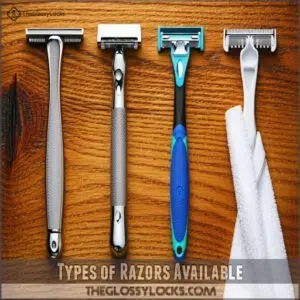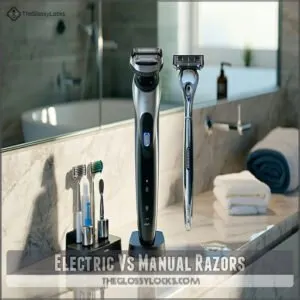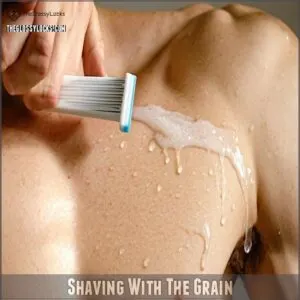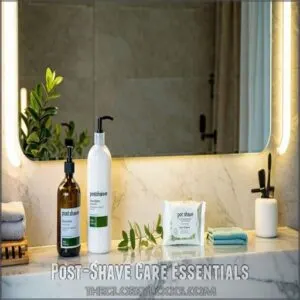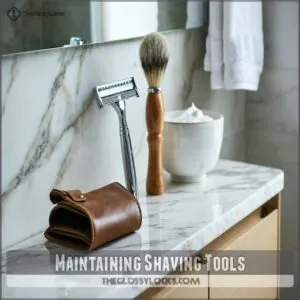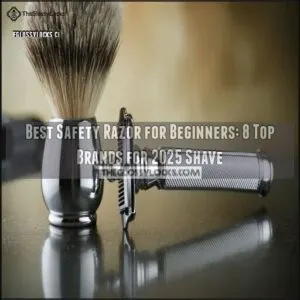This site is supported by our readers. We may earn a commission, at no cost to you, if you purchase through links.

You’ll need a gentle cleanser and warm water to prep your skin, followed by a quality razor that fits your grip.
Choose between electric shavers for speed or manual razors for precision – both work wonders when paired with the right shaving cream.
Remember to shave with the grain using light pressure, and don’t skip the post-shave moisturizer to keep your skin happy.
Your perfect shave is all about matching products to your skin type and following a consistent routine.
The secret to baby-smooth results lies in the details.
Table Of Contents
- Key Takeaways
- Preparing Skin for Shave
- Choosing Right Shaving Tool
- Shaving Techniques Explained
- Post Shave Care Essentials
- Maintaining Shaving Tools
- Shaving Frequency and Routine
- Shaving for Different Body Parts
- Troubleshooting Common Issues
- Selecting Best Shaving Products
- Frequently Asked Questions (FAQs)
- What to buy for first time shaving?
- How should a beginner shave?
- What shaving products do you need?
- What kind of razor should a beginner use?
- How long does a typical shaving cream last?
- Whats the ideal water temperature for shaving?
- Should I use both pre-shave oil and shaving cream?
- Can I share razors with family members?
- How do seasons affect my shaving routine?
- Conclusion
Key Takeaways
- You’ll need a gentle cleanser, warm water, quality razor, shaving cream, and moisturizer to build your basic shaving kit – choose between electric shavers for speed or manual razors for precision based on your needs.
- You should always shave with the grain using light pressure and keep your blade clean by rinsing frequently between strokes to prevent irritation and cuts, ensuring the best results for your skin.
- You’ll want to match products to your skin type – sensitive skin needs gentle, fragrance-free products; oily skin works well with most products; dry skin requires extra moisturizing before and after shaving.
- You’re going to need proper maintenance habits to extend your razor’s life – store it blade-up in a dry place, clean thoroughly after each use, and replace blades every 5-10 shaves or when you feel tugging during use.
Preparing Skin for Shave
Getting your skin ready for a shave is essential for achieving smooth, irritation-free results. Start with a gentle cleanser and warm water to remove dirt and open pores.
Skin Types and Hair Growth
Understanding your skin type and hair growth is key to a smooth shave.
Everyone’s skin reacts differently, so take note of:
- Sensitive skin? Use gentle shaving products to avoid irritation.
- Hair texture and growth patterns vary, so follow your hair’s natural direction.
- Skin conditions? Care for follicles with soothing products.
Start by knowing what works for your unique needs.
Exfoliation and Cleansing
Kick off your shave by exfoliating and cleansing your skin.
Use gentle Skin Exfoliants or Body Scrubs to remove dead cells, preventing clogged razors.
Pair this with mild Facial Cleansers or Gentle Soaps for a Deep Cleansing wash.
Match products to your skin type for best results.
Here’s a quick guide:
| Product Type | Purpose | Best For | Key Ingredient | Skin Sensitivity |
|---|---|---|---|---|
| Skin Exfoliants | Remove dead cells | All skin types | Salicylic acid | Low |
| Body Scrubs | Deep exfoliation | Rough areas (legs) | Sugar or salt | Moderate |
| Facial Cleansers | Gentle cleansing | Sensitive areas (face) | Aloe vera | High |
| Gentle Soaps | Mild cleansing | Everyday use | Oatmeal | High |
| Combination Products | All-in-one prep | Beginners | Charcoal | Varies |
The table provides a summary of different products and their uses, helping you choose the right product for your skin type.
Warm Water and Pore Opening
A warm compress or facial steaming acts like a cheat code for better shaving.
It softens the skin and opens pores, making hair removal smoother.
This thermal therapy preps your skin to absorb shaving products effectively.
For beginners, incorporating this step into your shaving kit guarantees easier glides.
Skin softening isn’t just pampering—it’s a rookie must for a nick-free shave, and it is also a key step for better shaving.
Choosing Right Shaving Tool
Selecting the right shaving tool can make a significant difference in your shaving experience, ensuring comfort and effectiveness.
With options like electric razors, safety razors, and straight razors, understanding their features helps you choose the best fit for your needs.
Types of Razors Available
Choosing your razor matters, especially for beginners.
Razors come in several types:
- Straight Razors – Classic but tricky, delivering ultra-close shaves with sharp blades and steady hands.
- Safety Razors – Cost-effective and eco-friendly, but they demand skill.
- Cartridge Razors – User-friendly with ergonomic grip, yet pricey.
- Disposable Razors – Affordable yet harsh on skin due to poor-quality blades.
To find the best razor types, consider factors such as shaving frequency, skin sensitivity, and personal preference when selecting a razor.
Electric Vs Manual Razors
Struggling with razor selection? Electric shavers offer ease, quickness, and electric safety, perfect for beginners.
Manual razors, however, let you control pressure for a closer shave and better blade durability.
For a wide selection of electric shaver models, explore these electric shaver product listings.
Both impact shave quality differently, so pick what fits your lifestyle.
See this quick comparison:
| Feature | Electric Shaver | Manual Razor |
|---|---|---|
| Razor Efficiency | Fast and consistent | Precise, customized |
| Blade Durability | Long-lasting | Requires replacement |
| Shave Quality | Even, less irritation | Smoother, closer |
| Electric Safety | Very safe | Requires care |
| Manual Control | Limited | Maximum flexibility |
Safety Razors and Straight Razors
If you’re ready to explore old-school precision, safety razors and straight razors are solid picks.
They offer different experiences, with safety razors providing comfort with protective features and replaceable blades, making them perfect for beginner shaving.
Straight razors, or the “straight edge,” demand skill but reward you with unparalleled closeness.
Focus on razor handles, blade sharpening, and mastering technique for lasting control over your shave.
Understanding the benefits of safety razor systems can also enhance your overall shaving experience.
Shaving Techniques Explained
Mastering proper shaving techniques guarantees a smoother shave, reduces irritation, and keeps your skin healthy. By shaving with the grain, using light pressure, and rinsing frequently, you’ll avoid common mistakes.
Shaving With The Grain
Shaving with the grain minimizes irritation and is a key tip in any beginner shaving guide.
Start by identifying your grain patterns—feel for resistance to map hair follicles. Understanding the shaving against grain technique is essential for a closer shave.
Follow these steps:
- Maintain a steady razor angle to glide naturally with your shave direction.
- Use light strokes for comfort.
- Gently stretch skin tension for a smoother pass.
Light Pressure and Rinsing
Now that you’ve learned to follow your hair growth pattern, let’s focus on pressure control.
Light, gentle strokes are your secret weapon – press just enough to glide the blade across your skin.
Between each stroke, rinse your blade in warm water to clear away hair and product buildup.
This keeps your shaving products working effectively and helps prevent irritation and cuts.
Reapplying Shaving Cream
If your razor starts tugging or your skin feels dry, it’s time for more cream.
Different shaving cream types create varying levels of protection, so pay attention to what works best.
Apply a thin, fresh layer after rinsing with cool water.
For the closest shave, warm the lather in your palms first – this razor glide aid helps your blade move smoothly without irritation.
Mastering the best lather techniques is essential to achieve a smooth and comfortable shaving experience.
Post Shave Care Essentials
You’ll need to take care of your skin after shaving to prevent irritation and maintain smoothness.
A proper post-shave routine, which includes cooling products and moisturizers, will help you avoid common issues like razor bumps and ingrown hairs.
Cooling and Moisturizing
Proper post-shave care transforms your skin’s comfort and appearance.
The right combination of cooling and moisturizing products helps prevent irritation while keeping your skin hydrated [22).
- Apply alcohol-free Soothing Gels with aloe and chamomile for immediate cooling relief
- Choose vitamin E-enriched Hydrating Serums to boost skin recovery
- Use Aftershave Balms with shea butter for deep moisturizing without stickiness
- Layer on Cooling Creams containing witch hazel to promote healing
- Finish with Moisturizing Oils enriched with essential oils for overnight repair
Addressing Razor Bumps
Those pesky red bumps after shaving aren’t a life sentence.
For effective bump prevention methods, especially if you have coarse or curly hair, use a single-blade razor and keep your hair length between 0.5-3mm.
Combat redness with natural skin soothing techniques like applying aloe vera gel or tea tree oil mixed with water.
Cool compresses and non-comedogenic moisturizers will reduce inflammation and calm your skin.
Ingrown Hairs and Cuts
You’ll need smart hair follicle care to avoid painful ingrown hairs and cuts.
Apply aftershave lotion with benzoyl peroxide or salicylic acid to prevent skin infection and trapped hairs.
For immediate ingrown remedies, stop shaving for 1-6 months until the area heals.
When cuts happen, use unscented shaving cream and breathable cotton clothing to support healing and cut prevention.
Maintaining Shaving Tools
You’ll need to take care of your shaving tools to guarantee they give you the best results and last longer.
Proper maintenance of your razors, including regular cleaning and careful storage, will protect your skin and save you money in the long run, which is a result of proper maintenance.
Cleaning and Storing Razors
Maintaining your shaving tools starts with smart razor maintenance . Once you’ve finished your post-shave routine, give your blade proper attention.
Effective cleaning solutions and dry handling make all the difference for your shaving kits .
- Store razors in a stand, blade up and away from moisture
- Clean thoroughly with warm water and pat dry with a clean towel
- Use rubbing alcohol monthly for deep razor sanitizing
- Keep your blade storage spot outside the bathroom to prevent rust
Blade Replacement and Sharpness
Your razor’s performance depends directly on blade sharpness, so change blades every 5-10 shaves or when you feel tugging.
Thick hair dulls blades faster, while proper care extends their life.
Watch for signs like skin irritation or resistance during shaving.
Try stropping your safety razor blades on denim to realign edges, and consider quality cartridge razors from subscription services for consistent blade durability.
To maintain superior razor performance, understanding proper blade maintenance is essential for extending the life of your blades.
Preventing Rust and Bacteria
The life of your blade depends on smart storage and cleaning habits.
Keep your shaving tools in pristine condition with proper rust prevention and bacteria control techniques.
Here are four proven methods to protect your investment:
- Rinse thoroughly with warm water and pat dry with a clean cloth after each use
- Store in a dedicated stand away from shower moisture
- Apply a protective coating to metal surfaces
- Consider monthly sanitizing with Barbicide solution
Shaving Frequency and Routine
You’ll need to establish a consistent shaving routine that matches your hair growth pattern and skin sensitivity.
Your ideal shaving frequency depends on your personal goals, ranging from daily maintenance to weekly touch-ups based on how quickly your hair grows back.
How Often to Shave
Your shaving frequency depends on personal preference and skin sensitivity.
For beginners, your hair type and growth rate will guide your daily routine, while some areas like faces need daily attention, others can wait.
You’ll know it’s time when hair regrowth becomes noticeable.
Those with sensitive skin should shave less often to prevent irritation, while coarser hair may require more frequent shaving cycles.
Creating a Shaving Schedule
Your morning shave deserves a consistent schedule that fits your daily rhythm.
Map out your personal shaving routine by tracking when your facial hair grows fastest and when you feel most alert.
Here’s what works for most beginners:
- Set a regular morning shave time before work or school
- Track your results in a simple notes app for two weeks
- Adjust your schedule based on hair growth patterns and skin’s response
This approach allows you to develop a routine that accommodates your personal shaving routine and daily rhythm.
Adjusting to Skin Types
After checking your skin type, tweak your shaving approach accordingly.
For sensitive skin, stick to fragrance-free products and gentle strokes with a fresh blade.
If you’ve got oily skin, you’ll find shaving easier thanks to natural lubrication.
Those with dry skin need extra moisture – always use a rich shaving cream and follow up with a soothing, alcohol-free moisturizer.
Shaving for Different Body Parts
You’ll need different techniques and tools when you’re shaving various parts of your body, from your face to your legs.
Whether you’re tackling chest hair or maintaining smooth underarms, each area requires specific attention to prevent irritation and achieve the best results, which involves understanding the importance of smooth underarms.
Shaving Chest and Back
Smart body grooming starts with your chest and back.
Based on expert recommendations, a methodical approach prevents common issues like razor burn and irritation.
- Start with a quality body groomer to trim longer hair before using a razor
- Apply shaving cream generously and let it soften the hair for 2-3 minutes
- Use short, gentle strokes in the direction of hair growth
- Replace blades regularly to prevent irritation and discomfort
- Moisturize daily between shaves to maintain smooth, healthy skin
Shaving Legs and Underarms
Begin your journey to silky-smooth legs and underarms with a warm shower to soften the hair.
Apply a moisturizing shaving cream in gentle upward strokes, then glide your razor up on legs and down on underarms using light pressure.
For sensitive skin areas like ankles and knees, take extra care and avoid stretching the skin too tight.
Rinse your blade often to prevent irritation.
Shaving Sensitive Areas
Moving from legs to more delicate zones needs extra attention to detail.
The best approach for sensitive skin tips starts with thorough preparation and the right tools.
- Take a warm shower first to soften hair and open pores
- Apply a fragrance-free shaving gel designed for sensitive skin
- Use gentle, short strokes in the direction of hair growth
- Keep skin taut while shaving to prevent nicks and cuts
For bikini line care, you’ll want to be especially careful.
Consider trying a single-blade safety razor, which can reduce irritation and provide better control while helping prevent ingrown hair solutions.
Troubleshooting Common Issues
You’ll find solutions to the most common shaving problems that can turn your smooth-skin dreams into a bumpy reality.
Whether you’re dealing with razor burn, ingrown hairs, or irritation, we’ll show you how to fix these issues and prevent them from happening again, which involves addressing problems like ingrown hairs.
Cuts and Razor Burns
Those pesky razor burns and cuts don’t have to ruin your day.
For quick burn treatment and razor burn relief, apply a cool compress immediately to calm the irritated skin.
Natural remedies like aloe vera or witch hazel provide effective skin soothing.
For cuts, use a nick roller with firm pressure to stop bleeding.
Keep the area clean and apply an antibacterial ointment for proper wound healing.
Ingrown Hairs and Bumps
Those pesky red spots after shaving aren’t just a cosmetic nuisance – they’re often ingrown hairs causing skin inflammation.
When hair grows back into the skin instead of breaking through, it creates those frustrating bumps.
Let’s tackle this common shaving challenge head-on.
Understanding shaving cream application is vital for preventing ingrown hairs and achieving smooth skin.
- Wet your skin with warm water for 2-3 minutes to soften hair follicles
- Use a gentle exfoliating scrub before shaving to prevent trapped hairs
- Always shave in the direction of hair growth using light pressure
- Keep your razor clean and sharp to minimize irritation
- Apply a post-shave treatment with salicylic acid to reduce bump formation
Skin Irritation and Redness
A cool, damp washcloth offers quick redness relief for sensitive skin after shaving.
For lasting results, apply alcohol-free aftershave lotion with aloe or chamomile for skin-soothing benefits.
Common irritation causes include dull blades and pressing too hard—ease up on pressure and swap blades every five shaves.
If discomfort persists, try unscented hydrocortisone cream for razor burn relief.
Selecting Best Shaving Products
You’ll find that choosing the right shaving products makes a significant difference in achieving a smooth, comfortable shave.
Your journey to better shaving starts with understanding which products work best for your skin type and personal needs, and recognizing the importance of better shaving.
Flexible Product Options
A personalized journey through product variety starts with exploring different options that match your skin’s needs.
Here are the top flexible choices for a smoother shaving experience:
- Sample premium shave creams with natural ingredients like Cremo Barber Grade
- Test both dry and wet-compatible electric razors for versatility
- Try Proraso’s affordable yet effective product line
- Experiment with Truefitt & Hill’s range of scented creams
- Consider safety razors with quality blade materials
When selecting a shaving cream, understanding shave cream types is essential for making an informed decision.
Mentoring and Guidance
Expert shaving coaches can guide you through the essential first steps of your grooming journey .
Personal advisors at local barber shops offer hands-on mentor tips and product recommendations customized to beginners.
For 24/7 shave support, connect with experienced mentors through online forums and guidance tools.
Professional shaving mentors help you build confidence while mastering essential techniques and avoiding common mistakes, which is a key part of the shaving process and essential techniques.
Frequently Asked Questions (FAQs)
What to buy for first time shaving?
Your smooth journey starts here!
You’ll need a mild safety razor or Braun Series 3 electric, quality shaving cream, a soft brush for lather, and aftershave balm.
Add a styptic pencil for backup.
How should a beginner shave?
Start with a gentle cleanser and warm water, then apply shaving cream generously.
Use light pressure, glide with the grain of hair, and rinse the blade frequently.
Take your time and avoid rushing.
What shaving products do you need?
Ever wondered what’s in a perfect shaving kit.
You’ll need a quality razor, shaving cream or gel, moisturizing aftershave, pre-shave oil, and a soft towel to get started with smooth results.
What kind of razor should a beginner use?
For your first go, pick up a 3-blade cartridge razor – it’s safe and simple to use.
You’ll find brands like Gillette and Schick offer reliable options with protective moisture strips and pivoting heads.
How long does a typical shaving cream last?
Your average 7-ounce can of shaving cream will last about 2-3 months when you’re using it regularly.
Stored properly in a cool, dry place, you’ll get the most value from your cream.
Whats the ideal water temperature for shaving?
You’ll find comfort and success with water between 100-120°F (8-9°C).
If you’ve got sensitive skin, lean in the direction of cooler temps, while straight facial hair benefits from warmer water’s softening effect.
Should I use both pre-shave oil and shaving cream?
Yes, you’ll benefit from using both.
Pre-shave oil softens hair and protects skin, while shaving cream provides essential lubrication.
Together, they create an ideal barrier that reduces irritation and helps prevent nicks.
Can I share razors with family members?
Never share razors with family members – it’s unsafe and risks spreading infections or blood-borne diseases.
You’ll want your own razor to maintain hygiene and guarantee the blades stay sharp for your specific needs.
How do seasons affect my shaving routine?
Harsh winter temperatures pull moisture from your skin, while summer’s heat causes excess oiliness. You’ll need extra moisturizer in cold months and lighter products during hot weather to prevent irritation.
Conclusion
Mastering your shaving routine takes practice, but you’re now equipped with essential shaving product recommendations for beginners to guide your journey.
Remember that everyone’s skin and hair are different, so don’t be afraid to adjust these techniques to suit your needs.
Whether you choose electric or manual razors, the key is consistency and proper care, stay patient with yourself as you develop your technique, and you’ll soon achieve the smooth, comfortable shave you’re looking for.
- https://www.gillettevenus.com/en-us/womens-shaving-guide/how-to-shave/beginners-guide-to-shaving-prep/
- https://www.byrdie.com/best-shaving-creams-4582653
- https://www.goodhousekeeping.com/beauty-products/g4834/best-razors-refillable-disposable/
- https://www.nytimes.com/wirecutter/reviews/best-manual-razor/
- https://www.theartofshaving.com/


